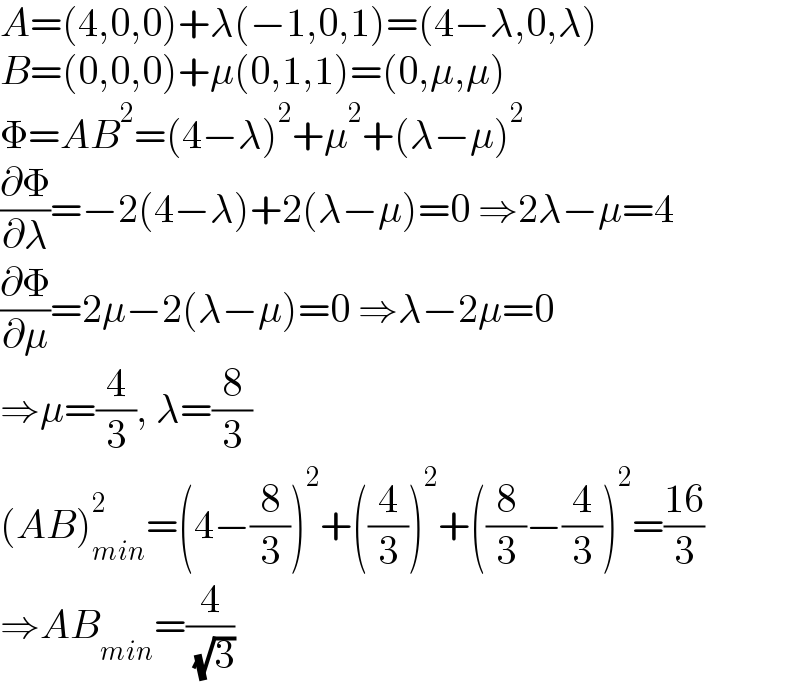
Question Number 178942 by cortano1 last updated on 23/Oct/22

Answered by mr W last updated on 23/Oct/22

Commented by mr W last updated on 23/Oct/22

$${A}=\left(\mathrm{4},\mathrm{0},\mathrm{0}\right)+\lambda\left(−\mathrm{1},\mathrm{0},\mathrm{1}\right)=\left(\mathrm{4}−\lambda,\mathrm{0},\lambda\right) \\ $$$${B}=\left(\mathrm{0},\mathrm{0},\mathrm{0}\right)+\mu\left(\mathrm{0},\mathrm{1},\mathrm{1}\right)=\left(\mathrm{0},\mu,\mu\right) \\ $$$$\Phi={AB}^{\mathrm{2}} =\left(\mathrm{4}−\lambda\right)^{\mathrm{2}} +\mu^{\mathrm{2}} +\left(\lambda−\mu\right)^{\mathrm{2}} \\ $$$$\frac{\partial\Phi}{\partial\lambda}=−\mathrm{2}\left(\mathrm{4}−\lambda\right)+\mathrm{2}\left(\lambda−\mu\right)=\mathrm{0}\:\Rightarrow\mathrm{2}\lambda−\mu=\mathrm{4} \\ $$$$\frac{\partial\Phi}{\partial\mu}=\mathrm{2}\mu−\mathrm{2}\left(\lambda−\mu\right)=\mathrm{0}\:\Rightarrow\lambda−\mathrm{2}\mu=\mathrm{0} \\ $$$$\Rightarrow\mu=\frac{\mathrm{4}}{\mathrm{3}},\:\lambda=\frac{\mathrm{8}}{\mathrm{3}} \\ $$$$\left({AB}\right)_{{min}} ^{\mathrm{2}} =\left(\mathrm{4}−\frac{\mathrm{8}}{\mathrm{3}}\right)^{\mathrm{2}} +\left(\frac{\mathrm{4}}{\mathrm{3}}\right)^{\mathrm{2}} +\left(\frac{\mathrm{8}}{\mathrm{3}}−\frac{\mathrm{4}}{\mathrm{3}}\right)^{\mathrm{2}} =\frac{\mathrm{16}}{\mathrm{3}} \\ $$$$\Rightarrow{AB}_{{min}} =\frac{\mathrm{4}}{\:\sqrt{\mathrm{3}}} \\ $$
Commented by Tawa11 last updated on 23/Oct/22

$$\mathrm{Great}\:\mathrm{sir}. \\ $$
Commented by mr W last updated on 23/Oct/22

$${alternative}: \\ $$$$\overset{\rightarrow} {{OP}}=\left(\mathrm{4},\mathrm{0},\mathrm{0}\right) \\ $$$$\overset{\rightarrow} {{n}}=\left(−\mathrm{1},\mathrm{0},\mathrm{1}\right)×\left(\mathrm{0},\mathrm{1},\mathrm{1}\right)=\left(−\mathrm{1},\mathrm{1},−\mathrm{1}\right) \\ $$$${AB}={d}=\mid\frac{\left(−\mathrm{1},\mathrm{1},−\mathrm{1}\right)\centerdot\left(\mathrm{4},\mathrm{0},\mathrm{0}\right)}{\:\sqrt{\left(−\mathrm{1}\right)^{\mathrm{2}} +\mathrm{1}^{\mathrm{2}} +\left(−\mathrm{1}\right)^{\mathrm{2}} }}\mid=\frac{\mathrm{4}}{\:\sqrt{\mathrm{3}}}\:\checkmark \\ $$
